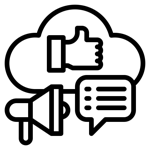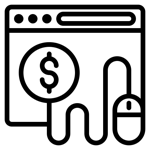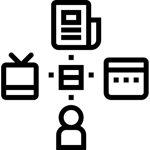
With the air of uncertainty that has followed these past few weeks and months, it can be challenging for many tour operators and business owners to decide what to do next with their business. Admittedly, every circumstance is unique, and it does not help when the floodgates of social media have inundated your feeds with confusing and sometimes conflicting action items.
One of those highly contested arguments might be: “Should I be marketing or promoting my tours during this time?” While it’s clear that the appetite for travel tourism has declined amid the recent news, completely pausing your marketing at a time like this would be a knee-jerk reaction. Additionally, there is an important distinction to make as businesses have a tendency to interchange marketing and promoting, when in fact promotion is just one discipline under the overall marketing umbrella. In the context of our industry, the act of promoting includes the activities, events, contests, etc. that create awareness of your tours and services. In short, it’s what you are doing to keep your tours in front of your customers and potential buyers. That being said, it is possible to continue your marketing efforts absent from your promotional tactics.
The blueprint of a digital marketing strategy, similar to that of a house, requires a solid foundation. When you remove those crucial components from your marketing, the ability to recover can become arduous. Keeping in line with this theme, here are some digital “housekeeping” items that you can be doing during this time to ensure your bounce back is as quick as possible.
 Search Engine Optimization & Website Optimization
Search Engine Optimization & Website Optimization
It’s no surprise that the recent outbreak has led to significant changes in organic search traffic across almost all industries, with travel being the most notable. Now more than ever, businesses should be focusing on ways to optimize their SEO to mitigate future losses; building organic traffic and SEO is all about playing the long game, and pulling your SEO efforts now could set your website back for years. Follow these suggestions to maintain your search superiority:
- Update Google My Business: GMB plays an important role in developing your local SEO and we’ve put together a GMB COVID-19 Checklist to walk you through the updates and modifications you can make during this time. Towards the beginning of the pandemic, however, Google temporarily removed certain features as a result of COVID-19. Despite the temporary limitations and delays in support, it is still in the best interest of your business and your customers to update your listing with current communication about your operations. Looking to set up our GMB profile? Start with our GMB checklist.
- Audit Your Website: In the past, you might have refrained from updating your website if you were either approaching your peak season or, quite frankly, not sure what to change. We have an entire Compass category dedicated to elements that you want to include on your website, but take this as an opportunity to audit and reevaluate key website elements such as your headings, metadata, on-page content, and keywords and ensure there is consistency with your dashboard item descriptions, booking flow, etc. Reviewing the article on 8 elements of a website that ranks and converts and the SEO checklist are great places to start.
- Link Building: Planning and executing a link building strategy doesn’t come overnight; it takes time. While the amount of time and resources can vary, the impact it has on your SEO is unquestionable. The sooner you can get started, the better, as we’ve all learned it can take three to six months for a site to reach its top position in the SERPs. Not sure where to start? Reach out to your local tour operators and businesses to discuss supporting each other during this time.
- Google Analytics: As working remotely becomes more of the norm, ensure you are taking the necessary precautions to protect the accuracy of your data by updating your IP-based filters to reflect the IP of you and your employees. You can easily locate your IP address through this page.
 Content Planning & Management
Content Planning & Management
It is easy to let content fall to the wayside, especially if you have decided to refrain from promoting your tours and services. However, similar to your website, now is as good a time as any to audit your content assets and take inventory of what is planned, developed, or gaps you’d like to fill. The goal is to understand what can be repurposed or refreshed, ideas for future posts, or decide what needs to be canceled. Here are some suggestions to follow:
- Review Scheduled Posts: If you are running a social management dashboard like HootSuite or Buffer, pause all scheduled content to verify it is still appropriate to send out.
- Analyze Top-performing Posts: Most content platforms have basic analytics included. Take a look at your content or posts from 2019 YTD. Look for the posts that drove the highest engagement, the most traffic, etc. and determine what elements drove those positive results: Was it the call to action? The subject line? Maybe the design?
- Refresh & Repurpose Content: Determine what can be refreshed or repurposed to other mediums – there’s no need to continuously reinvent the wheel! If you have content that performed well on one platform, tweak it and post it and see how it is received on a different platform.
- Get Organized and Start a Content Calendar: Alternatively, if your arsenal of content is not where you’d like it to be, now is the opportunity to set time aside for content batching. Start with planning content a week at a time, then, time permitting, try developing content for the upcoming month. You can populate your ideas in a Google doc or Google slide and share it among your team to brainstorm ideas. Our guide on creating a social media calendar is a great place to start.
- Give Video Marketing a Try: If you have been hesitant to adopt video marketing, now is the time to do the prep work! And no need to worry, you don’t need a fancy camera or sophisticated equipment to get started. Check out our overview of various video marketing platforms and strategies to get started. Videos can live in several platforms like your website, YouTube, social, etc., and not only do viewers retain 95% of a message through video (HubSpot), but videos also have a positive impact on your SEO.
 Social Media and Channel Management
Social Media and Channel Management
Amid the chaos, social media is quickly proving to be a critical infrastructure to share information. However, social media has also become an irreplaceable tool for easing our isolation and connecting in new ways. Remember that social media was also intended to humanize brands, develop trust, and create relationships. While we are using social media to monitor the news, we are also actively looking for additional outlets of engagement.
If you find yourself online, here are a few actions you can take:
- Social Engagement: Go through any recent posts you published and respond to or interact with any unanswered comments or questions.
- Stock Up on UGC: If you’re not familiar with User-Generated Content (UGC), it’s essentially leveraging or sharing content made by your customers and posting it on your channels. Ideally, you want to find images taken during your tour or service that you can use later on. Start by looking at the photos you were tagged in, or if your company has a hashtag (#), you can search for that specific hashtag. UGC can save you time on future posts and can inspire your follower base. Get started with this guide to UGC.
- Re-share Relevant Articles: Find an article or piece of content you think your audience will find interesting? Share it with your followers! Look for other accounts that are relevant to you and your customers and keep a running list of these accounts that you can source material from on a rainy day.
- Review Management: Similarly to social engagement, you want to make sure that you’ve taken the time to respond to any outstanding comments or feedback left on your business. Although Google My Business will not be publishing any new reviews or review replies right now, it is still a good practice to set time aside to respond to reviews. During this downtime, test out a review management process that you can implement in the future! Dedicate someone on your team to respond to existing and new review submissions to ensure they are all received and addressed in a quick manner. Develop canned messages or templates to use and coach them on how to appropriately handle negative reviews.
 Email Marketing
Email Marketing
- Update Your Contact List: If you find yourself regularly using an email service platform to contact clients, you might notice that you’re using an outdated list of email addresses. Ideally, anytime you have a new email subscriber or customer that has booked with your company, that email address should be added to your larger email list. Cross-reference your existing email list with your email service platform and run a Contacts Report in your dashboard to spot-check any differences in your total number of email addresses. You can also use this time to grow your email list.
- Clean Your Contact Lists: Alongside updating your list, you want to verify and remove any email addresses that have unsubscribed to receive your email messages or notifications.
- Segment Your List: Divide your larger email list into smaller lists or buckets based on characteristics or information you know about your customers. You are more likely to reach and resonate with your recipients by personalizing your messaging, increasing overall engagement. While it may be time-consuming, marketers have noted a 760% increase in revenue from segmented campaigns. Not sure where to start? Visit this list from Optinmonster for some ideas.
- Develop Email Templates: With any extra downtime, you may have, flex your creativity by getting a head start on designing new email templates with upgraded graphics. Visit our email marketing basics to understand what components you need to be including. You can start by creating an email for every stage of the buyer’s journey: Awareness, Consideration, Purchase, and Engagement.
 Paid Marketing
Paid Marketing
- Review PPC Spending: If you are running any pay-per-click marketing, whether it’s paid search, paid social, or retargeting, keep in mind that you are only paying for the clicks. Therefore, there is no reason to immediately shut down your campaigns. However, you should temper expectations and analyze your performance. The changes in organic search will have an impact on your PPC, especially paid search. According to Neil Patel, “you can still roughly pay the same amount per click, but the cost per conversion has been going up for most industries.”
- Create Audiences for Your Paid Marketing: Targeting your paid marketing campaigns is a great way to maximize your ROI, as you are setting up a specific group of individuals to see that ad. If you followed our recommendation to segment your audience for emails, you can take those same lists (or new lists) and upload them into your ad platform. Following the format requirements of each platform, the time to verify your lists can vary based on size. Generally, each ad platform requires a few days to begin “matching” your audience lists to their network.
- Clean Up Your Keywords and Negative Keywords: Search terms like “coronavirus” and “COVID” started to dominate search engines, and these phrases have been commonly attached or included along with terms like “travel” and “tourism.” Run a quick diagnostic of your search terms to understand what traffic your ads are receiving or what other keywords or phrases are being included in those searches. Should you notice any non-relevant keywords or terms associated with COVID-19, update your negative keywords accordingly to ensure your traffic is the most qualified.
- Set Up Your Website for Remarketing: If you’ve been itching to try your hand at remarketing or retargeting, you first need to set up a pixel or tag on your website. Using Google as an example, by following these instructions you can eventually show ads to people who’ve visited or completed an action on your website. Although you may not be running any remarketing currently, having this set up now will allow you to launch campaigns to previous visitors on your website quickly.
 Whether you decide to tackle all these items at once or over the course of the next few weeks, remember that “the best preparation for tomorrow is doing your best today.” Once you have reviewed your current digital marketing strategy based on the above, consider diversifying your marketing channels to increase your reach and resiliency to help bolster your company in challenging times.
Whether you decide to tackle all these items at once or over the course of the next few weeks, remember that “the best preparation for tomorrow is doing your best today.” Once you have reviewed your current digital marketing strategy based on the above, consider diversifying your marketing channels to increase your reach and resiliency to help bolster your company in challenging times.

 Search Engine Optimization & Website Optimization
Search Engine Optimization & Website Optimization Content Planning & Management
Content Planning & Management  Social Media and Channel Management
Social Media and Channel Management Email Marketing
Email Marketing  Paid Marketing
Paid Marketing  Whether you decide to tackle all these items at once or over the course of the next few weeks, remember that “the best preparation for tomorrow is doing your best today.” Once you have reviewed your current digital marketing strategy based on the above, consider diversifying your marketing channels to increase your reach and resiliency to help bolster your company in challenging times.
Whether you decide to tackle all these items at once or over the course of the next few weeks, remember that “the best preparation for tomorrow is doing your best today.” Once you have reviewed your current digital marketing strategy based on the above, consider diversifying your marketing channels to increase your reach and resiliency to help bolster your company in challenging times.